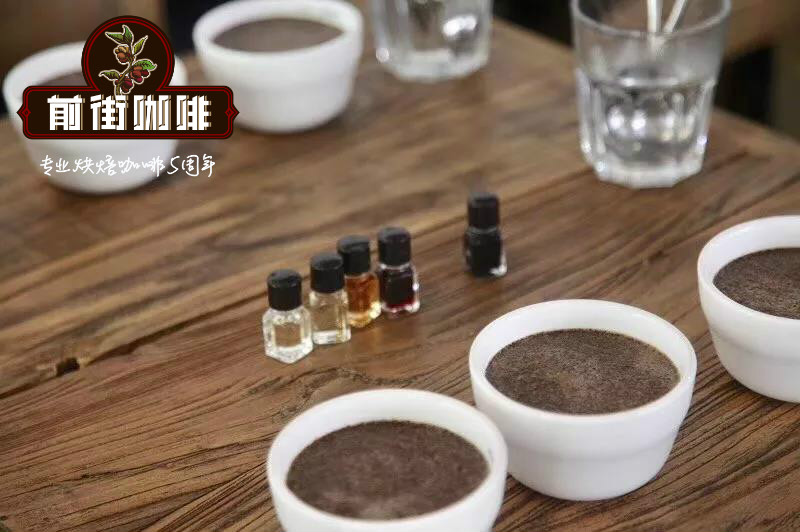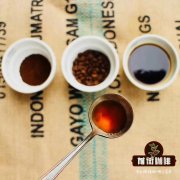How to drink bourbon coffee is important to distinguish the flavor of these coffees

Professional coffee knowledge exchange more coffee bean information please follow the coffee workshop (Wechat official account cafe_style)
Some people think that black coffee is bitter coffee, and the bitterness of coffee has always been controversial. Some people say: how can it be called coffee if it is not bitter? Some people say: good coffee has a pleasant bitterness.
Black coffee (that is, black coffee) refers to unmodified coffee, does not add sugar cream and other additions, including American, Italian concentrated and individual coffee.
Today we learn about single-item coffee. As the name implies, single-source coffee comes from a particular place, usually as specific as a farm, cooperative or estate. The culture of coffee is related to the geographical location, climate, soil conditions, etc.-give each coffee a unique taste from a single source.
Iron pickup and bourbon
Like drinking red wine, there are many varieties of coffee, only two of which are of real commercial value and are planted in large quantities, and the quality of the coffee beans produced by other coffee trees is also higher than that of other coffee trees.
If the variety of coffee is divided by biology, it can be divided into Arabica, Robusta and Liberica. The main varieties of drinking in the world are Arabica and Robusta. Generally speaking, Arabica is mainly used in single or boutique coffee, while Robusta is used to make instant coffee. Whether from the perspective of coffee culture or genetics, bourbon species and Tibica species are the two most important branches of Arabica coffee.
The propagation route of bourbon species
Red bourbon coffee Brazilian water washed red bourbon coffee
Introduced to Brazil in 1727 because of its low yield and easy to interfere with diseases, the bourbon species was introduced to Brazil around 1860 via Campinas in the south and rapidly expanded northward to other parts of South and Central America. In Latin America today, although most of the bourbon species have been basically replaced by their varieties (especially Caturra,Catuai and Mundo Novo, etc.), bourbon is still grown in El Salvador, Guatemala, Costa Rica, Peru and other countries.
After the red bourbon general coffee tree blossoms and bears fruit, the color change of the coffee fruit is: green > turn yellowish > turn slightly orange > turn mature red > turn more ripe dark red, so some people also call it [red bourbon], in fact, red bourbon, that is, what we call bourbon species. Bourbon planted at high altitude usually has a better aroma, while the acid is brighter and even tastes like red wine.
Generally speaking, bourbon is a coffee tree that belongs to a branch of Arabica species, generally bearing red fruit, called red bourbon, in addition to yellow bourbon, orange bourbon, yellow bourbon relatively low yield, but better quality.
Red bourbon coffee Tanzania missionaries wash bourbon
In Africa, French missionaries known as Spiritan (from the Holy Spirit) played an important role in the spread of the bourbon species. The first church was founded in Reunion in 1841 and a branch was established in Zanzibar in 1859, while from Zanzibar a branch was established in Bagamoyo (Bagamoyo, coast of Tanzania, then known as Tanganyika) and St. Augustine (Kikuyu, Kenya) in 1862, and a branch was established in Bura (Taita Hills, Kenya) in 1893. The establishment of each chapter was accompanied by the planting of coffee seeds from Reunion.
Seedlings cultivated by Bura in 1899 were brought to another French church in Santa Cruz (near Nairobi), introduced to the Kilimanjaro region of Tanzania, and distributed seeds to local residents who were willing to grow coffee, which was the origin of the so-called "missionary bourbon". Then the Kent species was introduced in 1920. Therefore, up to now, the coffee in Tanzania is mainly bourbon and Kent.
Coffee varieties: bourbon, grown between 1000 and 2500 meters, its refreshing acidity and medium mellowness complement sweet citrus and floral aromas.
Bourbon variety Costa Rica Kaddura
Caturra: the single gene variant of bourbon has better yield and disease resistance than bourbon. The tree is shorter, easy to harvest, more adaptable, can be planted with high density, does not need shade trees, and can also be alive in the sun, so he also has a name-"Sun Coffee".
Kaddura is suitable for high altitude areas ranging from 700m to 1700 m, but the higher the altitude, the better the flavor. High-quality Costa Rican coffee is called "extra hard beans", which can grow at an altitude of more than 1500 meters.
Costa Rica is the country where coffee was first introduced into Central America and has a long history. The coffee organization has a complete system from production to marketing. Because it is located in the Central American Gorge, the territory is full of volcanoes and has the natural advantages of sunshine and land, the coffee produced has the characteristics of local micro-climate and local conditions. In terms of quality and quantity, Costa Rican coffee has always been recognized by the world. It has been rated as one of the world-class high-quality coffee, giving birth to coffee beans with complete and rich flavor.
The transmission route of tin card species
Iron pickup coffee Yunnan Baoshan iron pickup coffee
Typica: the most classic high-quality Arabica species, which is derived from many commercial improvements at present. It has excellent taste and is recognized as a boutique coffee variety, but its yield is very low and it is vulnerable to rust, so more manpower management is needed. Tieka Coffee, native to Ethiopia and southeastern Sudan, is the most widely cultivated variety of coffee in the Western Hemisphere. The plant is stronger, but not light-tolerant, and the yield is higher in Hawaii. The top leaf of the iron pickup is red copper, which is called red top coffee.
Typica and bourbon were introduced in Baoshan City as early as the 1950s, and the locals called them "old varieties", because the old varieties had relatively low disease and insect resistance and yield, and were relatively labor-intensive in management. from the botanical point of view of coffee, Yunnan small-grain coffee was genetically similar to the recognized best blue mountains in Jamaica (Jamaica Blue Mountain) and Kona in Hawaii.
Unlike other beans, the fruit of Tieka coffee is cone-shaped. Iron pickup coffee is of high quality, so it is very popular in plantations all over the world. If planted properly, Tippica coffee has high sweetness, pure taste and pleasant acidity. Yunnan iron card, Asian herb aroma, lively and bright sour taste, both cheeks, sour soft, mellow balance, rich layers, Yuyun dark chocolate, honey, sucrose flavor, brown sugar flavor after complete cooling.
Iron pickup mutant Sumatra manning
Mantenin is also known as "Sumatran Coffee". Gayo is mostly produced in North Sumatra. Lake Tawa, which is dominated by ateng varieties, can be called Aceh Coffee or Lake Tawa (Tawar lake) Coffee, and the area between Lintong and Lake Toba lake in South Sumatra can be called Mantenin. Lindong is the producing area of Mantenin, and the best mantenin varieties have four varieties: Sidikalang, Bergendar, Siborong borong and Telok Sanggul.
Lake dopa, located in the central part of North Sumatra, was moved northward to the Lake dopa area by Dutch colonists in 1888, creating the modern Mantenin legend.
Lake Tawa is located in the middle of the Aceh Special Administrative region. Located at the northern tip of Sumatra, the area is less than 1/10 of Lake dopa. However, the quality and output of coffee have surpassed that of Lake dopa in recent years.
Mantenin has a strong taste, with a strong mellow and rich and lively sense of movement, neither astringent nor sour, mellow and bitter can be fully revealed. The appearance of Mantenin coffee beans is arguably the ugliest, but coffee fans say that the worse the Sumatran coffee beans are, the better, mellow and slippery they are.
Related recommendation: introduction of the difference between Brazilian yellow bourbon coffee beans by hand and red bourbon
Important Notice :
前街咖啡 FrontStreet Coffee has moved to new addredd:
FrontStreet Coffee Address: 315,Donghua East Road,GuangZhou
Tel:020 38364473
- Prev

Jamaica Coffee not only Blue Mountain how to distinguish Jamaican Coffee varieties
Professional coffee knowledge exchange more coffee bean information please follow the coffee workshop (Wechat official account cafe_style) there are three varieties of Jamaican coffee: Jamaican Blue Mountain Coffee (Jamaica Blue Mountain Coffee), Alpine Coffee (Jamaica High Mountain Supreme Coffee Beans) and Jamaican Coffee (Jamaica Prime Coffee)
- Next

How much do you know about bourbon coffee: why do coffee beans of the same variety have different flavors?
Professional coffee knowledge exchange more coffee bean information please follow the coffee workshop (Wechat official account cafe_style) early (coffee prehistoric) iron truck transplanted to Yemen after the mutation, the bean shape from thin to round. It was named bourbon in 1715 after France transplanted round beans from Yemeni mocha to the island of Bourbon on the east coast of Africa (renamed Reunion after the French Revolution). Bourbon round bean
Related
- Beginners will see the "Coffee pull flower" guide!
- What is the difference between ice blog purified milk and ordinary milk coffee?
- Why is the Philippines the largest producer of crops in Liberia?
- For coffee extraction, should the fine powder be retained?
- How does extracted espresso fill pressed powder? How much strength does it take to press the powder?
- How to make jasmine cold extract coffee? Is the jasmine + latte good?
- Will this little toy really make the coffee taste better? How does Lily Drip affect coffee extraction?
- Will the action of slapping the filter cup also affect coffee extraction?
- What's the difference between powder-to-water ratio and powder-to-liquid ratio?
- What is the Ethiopian local species? What does it have to do with Heirloom native species?

